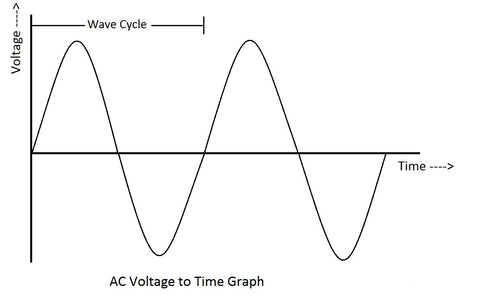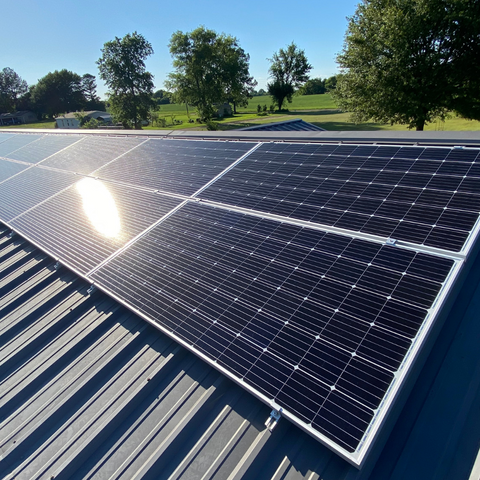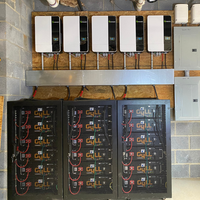SOLAR POWER EXPLAINED
Posted by Signature Solar on 12th Aug 2021
Overview:
There are two types of electric current: Direct Current (DC) and Alternating Current (AC). Solar panels produce Direct Current (DC), but the electrical equipment in your home uses Alternating Current (AC). If you made a graph of voltage vs. time for each type of current, you would see that direct current looks like a straight line, but alternating current goes up and down like a wave.

Actually, AC is often called a “sine wave” because its shape is the same as a math function called the “sine”. If you are trying to provide battery backup for your house in the event that the grid goes down, or if you are trying go completely off-grid, there is one important electrical rule you must keep in mind: You cannot have two different (non-synchronized) AC sine waves coming into the same breaker box at the same time.
Another important electrical rule you will need to know if you are using solar energy is what electricians call the “Power Rule”: Amps x Volts = Watts. This is true for both AC and DC. This is used to rate the DC wattage of solar panels. It also shows that a panel's current (in Amps) and voltage can be adjusted to achieve a certain amount of power (in Watts). If current goes up, voltage can go down, and vice versa.
On the AC side, most electrical equipment will contain a placard showing the maximum number of amps and volts the equipment uses. But remember, if you are talking about a compressor or other piece of electrical equipment, it will probably not be running all of the time. Also, the amperage shown on the placard is usually the maximum amperage used to start the compressor, not the “running” amperage used to keep the compressor running. There are several ways to estimate your electric usage:
(1) You can get equipment electric use estimates from the internet.
(2) For a particular piece of equipment or appliance, you can plug into a device called a KiloWatt that will record that equipment's use during a period of time.
(3) For your entire house, you can read your electric meter at a certain hour of the day, then read it again at a later time. The difference is the number of Kilowatt-Hours (KWH) you used during that time. Remember, KWH is what you buy from the electric company. This is the most reliable data because it is your actual use.
So let's look at the components of a solar electric system:
Panels:
Solar panels have a sticker on the back that tells the number of Amps, Volts and Watts they produce under ideal laboratory conditions called Standard Test Conditions or “STC”. These conditions are an irradiance (power coming in) of 1000 Watts/square meter, and a solar panel cell temperature 77 degrees F. In reality, panels hardly ever get this much irradiance because the sun is not exactly perpendicular to the panels. Also, and cell temperature is about 114 degrees F or more, which increases electrical resistance. The result is that actual panel production exceeds 80 percent of rated power for only about 5% of the day. This is an important point that most people don't understand. For this reason, solar designers typically use a “DC to AC ratio” of 1.2 to 1.3 for grid-tied systems. Try to design your system to be in this range or close to it. This increases inverter efficiency and avoids “clipping” caused by having too little power from the panels to feed the inverter.
Charge Controllers:
The Direct Current (DC) made by solar panels must be sent to a charge controller, in most cases also called an "MPPT" (for Maximum Power Point Tracking). Charge controllers "transform" the voltage of direct current from the panels to a voltage that can be accepted by the inverter. For a battery-based (off-grid) inverter, this is the voltage of the batteries. They also prevent battery voltage from flowing back to the panels at night, when panel voltage is zero, which would drain the batteries. Charge controllers can be purchased separately or included as part of an inverter. Inverters that are "grid-tied" (connected to the grid) almost always include their own charge controllers.
All charge controllers have an input voltage range. Panels are placed "in series" in a string, with the positive wire of one panel connected to the negative wire of the next panel, 'daisy chaining' or putting the panels in Series adds the panel voltages but the amperage (current) of the string stays the same as if it had only one panel. Several strings of panels can then be placed "in parallel", meaning all of the positives are connected together and all of the negatives are connected together. Paralleling strings adds the amperage of the strings together, but does not change the voltage of each string. If the charge controller does not have inputs for enough strings, you can bring the string outputs together in a small breaker box called a "combiner box". The DC power coming out of the charge controller is then sent to an inverter. We sell Growatt 80 Amp MPPT charge controllers, can be found here. Each charge controller can take up to 5000 Watts of panel input.
Inverters:
Inverters make alternating current (AC), which is what your house loads use, from the DC supplied by the panels. Good quality pure-sine-wave inverters make AC power that is actually cleaner (more standard) than the power supplied by the grid. There are 2 types of inverters, Off-Grid, Grid-Tied and Hybrid:
- Off-Grid inverters are constantly making their own AC power "sine wave" by drawing power out of batteries, even at night. They are typically connected to a 48 Volt battery bank. They produce this AC sine wave independently of any other device. As long as the batteries are above a certain voltage, they will continue to produce AC power and send it through a breaker to energize the loads in your breaker box. These inverters are also called "inverter/chargers" because they can "run in reverse", converting excess AC into DC, which charges the batteries. This is one of two possible ways that solar (not generator) power can charge batteries. The other way is to connect solar panels to a charge controller which charges the batteries directly whenever the sun is shining. Some off-grid inverters, such as the Growatt models we sell, include their own MPPT charge controller, but you can also purchase additional charge controllers separately. All MPPT charge controller outputs are then connected in parallel to the same positive and negative terminals of the battery bank. The overall electrical efficiency of an off-grid inverter is usually a little below 90%. Shop Off Grid Inverters Here
- Grid-Tied inverters are "followers". Since they don't have batteries, they don't operate at night. Even during daylight hours, they don't turn on unless they see a sine wave (AC current) coming from somewhere else. This is called the "anti-islanding" feature of grid-tied inverters and is denoted on the spec sheet as "UL 1741". Utilities require this to protect their workers from being injured or killed by solar-generated current travelling through the grid's electric lines when the grid is down. Grid-tied inverters are not able to detect where a sine wave is coming from, but when they detect it, they produce an AC power sine wave that is synchronized with it. (AC sine waves must be synchronized to prevent an explosion; this is why multiple grid-tied inverters can be connected in series). A grid-tied inverter can't detect whether an AC sine wave is produced by the grid or by an off-grid inverter. The overall electrical efficiency of grid-tied inverters is usually about 98%. Shop Grid Tie Inverters Here.
- Hybrid inverters combine the functions of grid-tied and off-grid inverters. They connect to the grid and they can produce power from batteries when the grid is down. But there is a catch: In most cases, they can back up only part of the circuits that they can operate in grid-tied mode. The circuits backed up by batteries must be wired into a separate breaker box, called a “sub-panel”, so that the power they produce from batteries cannot be fed back to the grid. Also, if you need more than one hybrid inverter for your house, the inverters must be “stacked” meaning that the AC sine waves coming from the battery-based part of all of the hybrid inverters must be synchronized. This can be accomplished by hardware and software, but it increases the cost of the system.
Rapid Shutdown:
The 2017 version of the National Electrical Code requires that rapid shutdown devices be connected to each panel on the roof of an occupied building as an additional means of fire protection. Our best value to meet this requirement is the NEP PVG-2 rapid shutdown which can handle up to 2 solar panels of any size, and also provide panel-level monitoring.
Racking:
This can't be decided exactly until you decide how many panels you need and how they will be placed on the roof. We sell mini-rail racking for shingle/asphalt, metal R panel, and standing seam roofs.

Each bracket attached to the roof can be screwed into a rafter or into blocking between the rafters. (It can be screwed into the decking but we don't recommend this). For shingle roofs, each bracket comes with its own pre-drilled flashing piece to protect the roof underneath from leaks. A "mini-rail" 6 inches long is connected to the top of the bracket and can be pointed in either direction, depending whether the panels are landscape or portrait. Each mini-rail is then located under the "seam" between two adjacent panels or at the end of a row of panels (see photos of T-shaped "mid clamp" and "end clamp" with bracket and flashing). We would usually place two mini-rails along a seam between two panels, and two at the end of a row of panels.
Batteries:
Going off-grid means operating on an energy budget, some of us at Signature Solar refer to this as an ENERGY DIET. This can be done, but it requires a little planning and foresight. For most of the U.S., almost all solar electric production occurs between 10 AM and 3 PM. If you want to avoid running your generator, even on sunny days, you will need enough battery capacity to take you from about 3 PM on one day until about 10 AM the next day, a span of 19 hours, so you need to know how many Kilowatt-Hours (KWH) you will consume during these hours. (A Kilowatt-Hour is 1000 Watts used for one hour). The good news is that you can change this number drastically by shifting large electrical loads to times when the sun is shining. "Large electrical loads" would include things like HVAC, the dryer, an oven, or the swimming pool. Running the AC at full capacity during sun hours will adjust the "thermal mass" (heat capacity) of the house so that the batteries don't have to work so hard at night; the same is true for a furnace or heat pump. You can devise ways to keep more heat or cold inside your house. Most heat is lost through windows, and we have found that insulated curtains can work wonders. Other more constant compressor loads like refrigerators and freezers are going to run 24 hours a day, but you can look at their placard to see how many Watts they use (remember, Amps x Volts = Watts). Of course, the compressor is not running all the time. You can get a plug-in meter such as a Kill-A-Watt to determine how many Watts an appliance actually uses in an hour.
We sell 51.2 Volt, 5.12 KWH Lithium Iron Phosphate (LiFePO4) batteries-- Check Those Out Here. You can put 6 of them in a roll-around cabinet like that shown in the photo. T

hey will work with the any nominal 48 Volt off-grid inverter such as the Growatt models we sell. These Lithium Iron Phosphate batteries are designed for 6000 cycles at 80 percent depth of discharge. This means one of these batteries can provide 4.1 useable Kilowatt-Hours. By comparison, the 12 Volt sealed off-grid "nanocarbon" (matted) lead-acid battery we purchased 4 years ago for $180 each can only be discharged 25 percent of the nameplate rating, so each 4 battery string (to make 48 Volts) provides 5 KWH x 0.25 = 1.25 KWH. In other words, it takes 13 of the 12 Volt sealed lead-acid off-grid batteries to equal the storage capacity of one Lithium Iron Phosphate battery. Lead-acid batteries last several years if you are careful with them, but our Lithium Iron Phosphate batteries are designed to last over 16 years. They are "prismatic", meaning that the Battery Management System (BMS) has to manage only 16 blocks of LiFePO4, instead of hundreds of "18650" cells the size of AA batteries as in competitive models. Also, LiFePO4 is not subject to thermal runaway (overheating) as Lithium Ion batteries can be, but they should be maintained above 32 degrees F.

